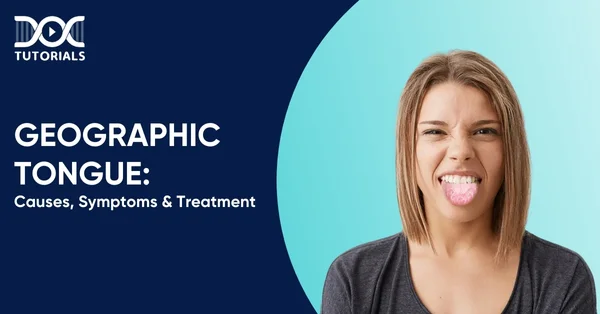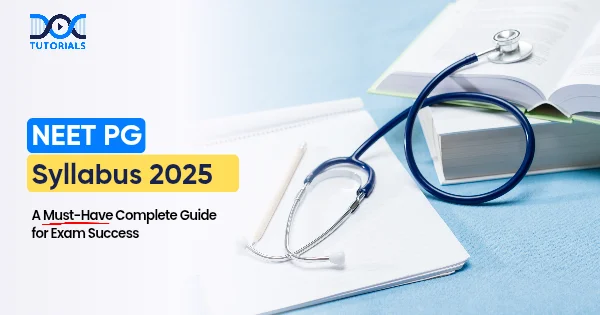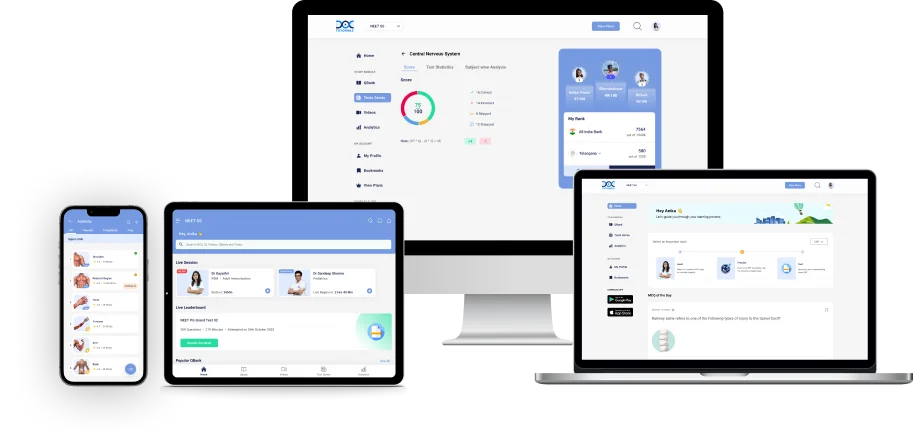Geographic Tongue NEET PG Guide |Causes, Symptoms & Treatment

Geographic tongue is an inflammatory disease, also known as benign migratory glossitis. It appears as smooth, red patches on the tongue’s sides and top. The term “geographic” tongue comes from the fact that these patches are usually surrounded by slightly elevated, white or light-coloured edges, which gives the tongue a map-like appearance.
Over time, the patches’ location, size, and shape may vary and migrate from one part of the tongue to another. Geographic tongue is innocuous, unrelated to infection or cancer, and not communicable despite its remarkable appearance.
For NEET PG aspirants, learning about this medical condition is crucial for covering their syllabus. Here is a detailed guide on the geographic tongue causes, risk factors, symptoms, diagnosis, and treatment.
What are the Causes of Geographic Tongue?
Though the exact geographic tongue causes are not yet known, here are some of the factors that can lead to the development of such conditions:
- Celiac Disease
It is a gluten allergy that occurs abnormally and leads to severe digestive issues. As per studies, 15% of individuals with geographical tongue disease were affected by celiac disease.
- Lichen Planus
It is another inflammatory condition that leads to lesions and bumps inside the mouth or on your skin’s surface. The oral form of this condition leads to geographic tongue.
- Psoriasis
It refers to skin cells that build up on the skin surface, leading to thick, itchy, and scaly patches. Psoriasis causes geographic tongue, which is oral psoriasis, according to experts.
- Pregnancy
During pregnancy, hormonal changes and the baby’s nutritional needs can deplete the mother’s vitamin levels. This can lead to deficiencies that may cause symptoms like those seen in geographic tongue, such as red, smooth patches on the tongue’s surface.
- Vitamins and Mineral Deficiencies
Lack of vitamin B, especially B6, B12, and folate, can lead to inflammation and swelling of the tongue, as well as smooth, bald patches on the tongue where the papillae are missing. These deficiencies increase the risk of developing geographic tongue.
In addition to B vitamins, low vitamin D, zinc, and iron levels have also been linked to this condition. Ensuring adequate intake of these nutrients may help reduce the likelihood or severity of geographic tongue symptoms.
What are the Risk Factors of Geographic Tongue?
Though geographic tongue can affect individuals of all ages, it is most common in young adults. Besides, women are more affected than men. Here are some of the common risk factors for geographic tongue:
- Type 1 diabetes
- Arthritis of specific types
- Eczema
- Family history of a similar disorder
- Fissured tongue
- Folic acid, zinc, vitamin B6, B12, and iron deficiency
- Those who are using hormonal birth control
- Excessive stress
- Allergies, etc.
What are the Symptoms of Geographic Tongue?
Geographic tongue symptoms include the following:
- The size, shape, and location of the patches may change frequently
- Red, smooth patches on the tongue’s top side that look like irregularly shaped sores
- Feeling of pain or a burning sensation while eating acidic or spicy foods
There are many cases where the geographic tongue has no symptoms. It may continue for as long as years or days and get cured on its own. However, the chances of reappearing are always there.
How to Diagnose Geographic Tongue?
Diagnosis of geographic tongue is primarily clinical, based on the characteristic appearance of the tongue during an oral examination. The process may include:
- Visual inspection of the tongue and oral cavity using a lighted instrument
- Asking the patient to move their tongue to assess discomfort or changes in texture
- Checking for signs of infection, such as fever or swollen lymph nodes
- Ruling out other medical conditions that can cause similar symptoms
Laboratory tests are rarely necessary unless the doctor suspects another underlying condition or nutritional deficiency.
What are the Methods for Geographic Tongue Treatment?
Most cases of geographic tongue do not require treatment, as the condition is benign and often asymptomatic. However, if symptoms such as pain or burning are bothersome, several management strategies can help:
- Over-the-counter Pain Relievers: For mild discomfort
- Anti-inflammatory Medications: To reduce inflammation if needed
- Mouth Rinses with Anaesthetic or Antihistamine: To numb the tongue and alleviate pain
- Topical Corticosteroids: Applied directly to the tongue to reduce inflammation
- Vitamin and Mineral Supplements: Particularly if deficiencies are identified
- Avoidance of Triggers: Limiting spicy, acidic, or salty foods, as well as tobacco and toothpaste with harsh additives, can reduce symptoms.
The condition typically improves on its own, and recurrences are common but not harmful.
FAQs About Geographic Tongue
- Is geographic tongue contagious?
No, geographic tongue is not contagious and cannot be passed to others.
- Can geographic tongue be a sign of a more serious health problem?
While geographic tongue is generally harmless, it can sometimes be associated with other conditions like psoriasis or nutritional deficiencies. If you have concerns, consult your healthcare provider.
- Does geographic tongue affect taste or eating?
Most people do not experience changes in taste, but some may notice increased sensitivity or mild discomfort when eating certain foods.
- Can children develop a geographic tongue?
Although it is more common in adults, children can also develop geographic tongue. However, young adults and women are more prone to the risk.
- Will geographic tongue ever go away completely?
The condition often resolves on its own without any treatment. However, symptoms may recur periodically throughout the affected person’s life.
Conclusion
Geographic tongue is a benign, non-contagious oral condition marked by map-like red patches on the tongue. While its appearance can cause concern, it is usually harmless and often asymptomatic. The exact cause remains unknown, but genetic factors, associated health conditions, nutritional deficiencies, and hormonal changes may play a role.
If you are a NEET PG aspirant, gathering in-depth knowledge about the geographic tongue is essential, as it is included in the syllabus. In this regard, DocTutorials can assist you like a pro. Our online classes, video lectures, practice sessions, etc., are focused on extending your knowledge and taking your exam preparation to the next level. Join our NEET PG courses for a successful medical career!
Latest Blogs
-

NEET SS Exam 2024: Analysis, Key Dates, Counselling
The NEET SS 2024 exam kicked off on March 29, 2025. Over two days and two slots, candidates across 13…
-

NEET PG Registration 2025: An Essential Guide For Exam Prep
The NEET PG registration, which is conducted online, is a crucial step in the exam process. Filling out the NEET…
-

NEET PG Syllabus 2025: A Must-Have Complete Guide for Exam Success
The NEET PG Syllabus acts as one of the foundation stones for aspiring postgraduate medical students like you who are…




